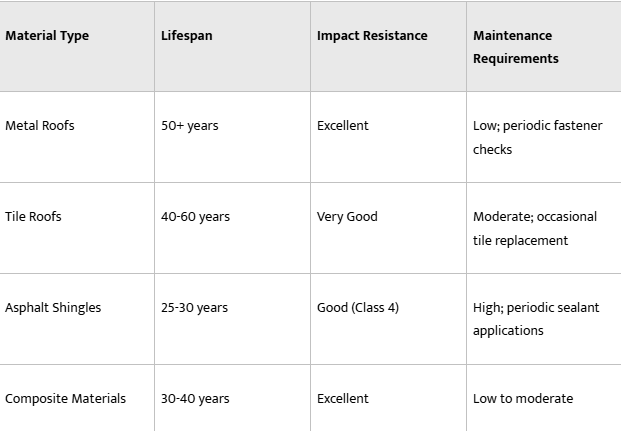Essential Hurricane Resistant Roofing Materials for Homeowners

Hurricane Resistant Roofing Materials You Need to Know
Introduction
Hurricane resistant roofing is essential in regions facing extreme weather, protecting homes and businesses from high winds, floods, and storm damage. In fact, many experts advocate for hurricane roofing as an added measure for enhanced durability. This article outlines top roofing materials designed to resist hurricanes, explains the impact of roof geometry, and details the critical components and proper installation methods to ensure long-term performance. With these insights, readers can make informed decisions to safeguard their properties.
Key Takeaways
- Examines various hurricane resistant roofing materials including metal, tile, asphalt, and composite options.
- Explains how roof geometry, such as hip and gable designs, affects wind resistance.
- Highlights critical components like fortified roof decks, superior underlayment, secure fasteners, and effective flashing.
- Emphasizes that proper installation and regular maintenance are key to roof resilience.
- Provides factors like cost, longevity, aesthetics, and warranty considerations to guide material selection.
Identifying Leading Hurricane Resistant Roofing Materials
Experts evaluate roofing materials based on impact resistance, lifespan, maintenance, and overall performance in severe weather.
Metal Roofs the Gold Standard for Hurricane Resistance
Metal roofs perform exceptionally in high winds and heavy debris impacts due to their strength and ductility. Their seamless, interlocking panels minimize water intrusion during storm surges. With wind speeds surpassing 140 mph, metal roofs offer long life, low maintenance, and eco-friendly recyclability.
Durable Tile Options Among Hurricane Resistant Roofing Materials
Tile roofs, typically made of clay or concrete, provide fire resistance and enhanced durability. Their weight and interlocking design help resist wind uplift, with tests showing performance up to 120 mph. Although tile roofs can be more expensive, their long lifespan and superior thermal performance help offset initial costs.
High-Performance Asphalt Shingles for Storm Prone Areas
Asphalt shingles are popular because of their easy installation and versatility. Modern formulations include polymers and advanced granules that boost impact resistance and reduce water penetration. Impact-rated shingles (e.g., Class 4) are tested to endure hail and debris impacts, with warranties often exceeding 30 years when maintained properly.
Composite Materials a Modern Choice for Hurricane Roofing
Composite roofs, combining fiberglass and polymers, offer a lightweight yet robust alternative. Their engineered layers dissipate impact energy efficiently, protecting against localized damage during severe weather. They also resist mold and mildew growth and provide a sleek, modern appearance.
Examining Impact Ratings of Hurricane Resistant Roofing Materials
Impact ratings, such as UL 2218, gauge a roof’s ability to withstand high-speed debris impact. Metal roofs, along with specially engineered asphalt and composite options, typically score high. These ratings ensure materials not only meet building codes but also provide homeowners peace of mind during storms.
How Roof Geometry Influences Performance in High Winds

Roof geometry significantly affects a structure’s response to hurricane-force winds. The shape and layout can either deflect wind forces or create vulnerabilities that lead to damage.
The Aerodynamic Advantages of Hip Roof Designs
Hip roofs feature gentle, continuously sloping sides that allow wind to flow smoothly, reducing turbulence and pressure buildup. Their aerodynamic shape minimizes wind uplift and distributes stress evenly, making them ideal in high wind regions.
Mitigating Risks Associated With Gable Roofs in Storms
Gable roofs, with their simple design, may experience increased wind uplift on large vertical ends. Reinforcing these roofs with additional bracing, wind clips, and hurricane straps is vital to minimize uplift and ensure compliance with modern building codes.
Flat and Low Slope Roof Considerations for Hurricane Zones
Flat and low-slope roofs can face issues like water pooling and lower aerodynamic efficiency. Enhanced performance in these designs is achieved through proper drainage, high-performance waterproof membranes, and reinforced underlayment systems to prevent water intrusion.
Optimizing Roof Pitch for Wind Resistance
The pitch of a roof is critical in balancing water penetration with wind uplift forces. Roofs with moderate pitches (approximately 4/12 to 8/12) offer optimal resistance to gust-induced damage and can better accommodate local climate conditions.
The Protective Benefits of Multi-Sided Roof Structures
Designs that combine elements of hip and gable roofs, such as cross gable structures, help distribute wind forces over several planes, reducing localized stress. When paired with reliable fastening and high-quality underlayment, multi-sided roofs provide robust hurricane protection.
Critical Components for a Storm Resilient Roofing System
A storm resistant roofing system relies on a combination of durable materials and well-coordinated components designed to work together for maximum protection.
Fortifying the Roof Deck Against Uplift Forces
The roof deck is the foundation of the roofing system. It must be constructed with materials like plywood or OSB and securely fastened to resist wind uplift. Adhering to proper nailing patterns and reinforcement techniques is critical to maintain deck integrity under extreme stress.
The Necessity of Superior Underlayment for Water Intrusion Prevention
Underlayment serves as the secondary barrier protecting the roof deck from water intrusion. High-quality waterproof membranes or synthetic underlayments resist wind-driven rain and debris impact, ensuring continued protection even if the primary roofing material is compromised.
Secure Fastening Methods for All Hurricane Resistant Roofing Materials
Fasteners, whether nails, screws, clips, or hurricane straps, are essential for securing roofing materials during strong winds. Certified fastening methods that comply with building code guidelines are crucial for preventing catastrophic roof failure.
Understanding Flashing Details for Vulnerable Roof Areas
Flashing, typically made of metal, is installed around roof penetrations and vulnerable areas to keep water out. Correct overlapping and use of flexible, high-quality sealants are essential to prevent leaks during hurricanes.
Adherence to Strict Building Codes for Hurricane Regions
Building codes in hurricane-prone areas set stringent standards for materials and construction methods. Compliance with these codes through proper material selection, fastening, underlayment, and flashing is critical for ensuring a roof can withstand severe weather.
Proper Installation Techniques for Hurricane Resistant Roofing

Even the best materials can fail if not installed correctly. Following manufacturer guidelines and building codes during installation is as important as selecting high-quality materials.
Selecting Certified Installers for Your Hurricane Roof
Hiring certified roofing contractors ensures proper installation. These professionals are well-versed in local codes, use specialized tools, and provide documentation and warranties, significantly reducing the risk of installation errors.
Following Manufacturer Guidelines for Optimal Wind Performance
Manufacturers’ installation guidelines are designed to optimize performance. Adhering to specified fastener types, nailing patterns, and overlap distances is vital for maximizing wind resistance and maintaining warranty coverage.
Verifying Correct Nailing Patterns and Fastener Types
Regular inspections during installation help ensure that the correct nailing patterns and fastening methods are used. These checks are essential to prevent wind uplift and maintain the roof’s integrity.
Ensuring Adequate Attic Ventilation in High Wind Design
Proper attic ventilation reduces heat and moisture buildup, extending the lifespan of roofing materials. Techniques such as installing ridge and soffit vents correctly help maintain air balance and enhance structural performance during storms.
Post-Installation Inspections for Quality Assurance
After installation, professional inspections verify that all components meet manufacturer specifications and building codes. Regular follow-up inspections help detect and repair minor issues before they escalate into major problems.
Assessing and Comparing Your Hurricane Roofing Choices
Choosing the right roofing material involves evaluating factors such as lifespan, cost, aesthetics, and maintenance requirements.
Evaluating the Lifespan of Different Hurricane Resistant Roofing Materials
Metal roofs can typically last over 50 years, tile roofs 40–60 years, asphalt shingles 25–30 years, and composite roofs fall in between. These lifespans vary with installation quality and local weather conditions.
Cost Benefit Analysis of Upgrading to a Hurricane Proof Roof
While hurricane resistant roofs may have higher upfront costs, their durability, reduced maintenance, and potential for lower insurance premiums can make them a cost-effective long-term investment.
Matching Aesthetics With Performance in Storm Resistant Roofing
Modern hurricane resistant materials offer a variety of colors and textures. Options like textured metal panels or decorative tile can provide both function and visual appeal, meeting homeowners’ aesthetic and protective needs.
Deciphering Warranties for Hurricane Resistant Roofing Materials
Warranties for these roofing materials can range from limited periods to lifetime coverage on select components. Reviewing warranty terms carefully helps ensure that the investment is protected against defects and improper installation.
Factoring in Maintenance Needs for Various Material Types
Maintenance varies among roofing materials: metal roofs require occasional fastener checks, tile roofs may need individual tile repairs, and asphalt shingles require periodic cleaning and sealing. Understanding these requirements is key to long-term performance.
Maintaining Your High Wind Resistant Roof for Lasting Protection
Regular maintenance is crucial for ensuring that a hurricane resistant roof remains effective throughout its lifespan. Routine inspections and prompt repairs help prevent minor issues from becoming major problems.
Conducting Regular Roof Inspections Before and After Storm Season
Homeowners should schedule inspections at least twice a year—before and after storm season—to check fasteners, flashing, underlayment, and overall roof condition. Prompt attention to small issues can prevent major failures.
Prompt Repair of Minor Damage to Prevent Escalation
Addressing small problems, such as loose shingles or minor flashing cracks, immediately can reduce repair costs and prevent more serious damage during subsequent storms.
Keeping Gutters and Drains Clear for Proper Water Management
Regular cleaning of gutters, downspouts, and roof drains is essential for ensuring that water flows away from the roof. This practice prevents water backup, which can undermine the underlayment and lead to leaks.
Checking Seals Around Vents, Pipes, and Skylights
Roof penetrations are vulnerable areas that require periodic resealing with high-quality, flexible sealants. Maintaining these seals is key to preventing water intrusion and maintaining aerodynamic integrity.
Knowing When Professional Re-Roofing Becomes Necessary
Even with regular maintenance, roofs eventually require professional re-roofing when damage accumulates or materials age. Recognizing signs such as chronic leaks or sagging can help homeowners decide when to invest in a complete roof replacement.
Table: Comparison of Hurricane Resistant Roofing Materials
Before selecting a roofing material, consider these key performance attributes:

Regular professional consultations can help ensure that the chosen system meets both performance and financial requirements.
Final Thoughts
Hurricane resistant roofing materials are fundamental to effective storm protection. By carefully evaluating options—from robust metal and durable tile roofs to advanced asphalt and composite systems—homeowners can mitigate the risks posed by hurricanes. Optimal roof geometry, critical components, and proper installation are all integral to achieving lasting protection. With proactive maintenance and timely repairs, a well-selected roofing system safeguards property and provides lasting peace of mind. Homeowners should consult experienced professionals to tailor a roofing solution to their environmental and aesthetic needs.
Frequently Asked Questions
Q: What makes hurricane resistant roofing materials different from standard roofing?
A: These roofs are engineered to withstand high winds, water intrusion, and flying debris using advanced materials and installation techniques that comply with strict building codes.
Q: How do roof geometry and design influence a roof’s wind resistance?
A: Designs such as hip roofs and moderate pitch angles promote aerodynamic performance by reducing uplift forces and evenly distributing wind pressure.
Q: Why is regular maintenance crucial for hurricane resistant roofs?
A: Routine inspections, prompt repairs, and clean gutters help prevent minor issues from escalating, ensuring the roof maintains its protective qualities during severe storms.
Q: Can upgrading to a hurricane resistant roof lower home insurance premiums?
A: Yes, many insurance companies offer reduced premiums for homes with roofs that meet enhanced wind and impact resistance standards.
Q: How should homeowners decide which roofing material to choose?
A: Consider factors such as longevity, aesthetics, maintenance needs, warranty details, local weather patterns, and budget constraints when making a decision.



